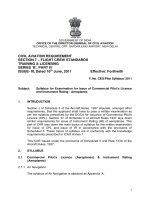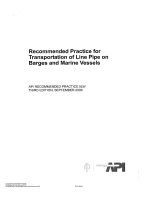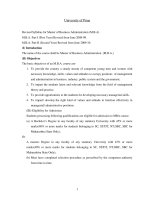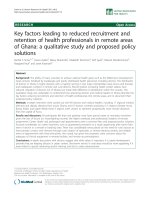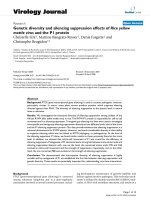Syllabus for Examination for Issue of Commercial Pilot’s Licence and Instrument Rating - Aeroplanes doc
Bạn đang xem bản rút gọn của tài liệu. Xem và tải ngay bản đầy đủ của tài liệu tại đây (293.14 KB, 64 trang )
GOVERNMENT OF INDIA
OFFICE OF THE DIRECTOR GENERAL OF CIVIL AVIATION
TECHNICAL CENTRE, OPP. SAFDARJUNG AIRPORT, NEW DELHI
CIVIL AVIATION REQUIREMENT
SECTION 7 – FLIGHT CREW STANDARDS
TRAINING & LICENSING
SERIES ‘B’, PART IV
ISSUE- III, Dated 16
th
June, 2011 Effective: Forthwith
F. No. CEO/Pilot Syllabus/ 2011
Subject: Syllabus for Examination for Issue of Commercial Pilot’s Licence
and Instrument Rating - Aeroplanes
1. INTRUDUCTION
Section J of Schedule II of the Aircraft Rules, 1937 stipulate, amongst other
requirements, that the applicant shall have to pass a written examination as
per the syllabus prescribed by the DGCA for issuance of Commercial Pilot’s
Licence (CPL). Section ‘O’ of Schedule II of Aircraft Rules 1937 lays down
similar requirements for issue of Instrument Rating (IR) of aeroplanes. This
part of CAR lays down the main topics of syllabus for the written examination
for issue of CPL and issue of IR in accordance with the provisions of
Scheduled II. These topics of syllabus are in conformity with the knowledge
requirements prescribed in ICAO Annex 1.
This CAR issued under the provisions of Scheduled II and Rule 133A of the
Aircraft Rules, 1937.
2. SYLLABUS
2.1 Commercial Pilot’s Licence (Aeroplanes) & Instrument Rating
(Aeroplanes)
2.1.1 Air Navigation
The syllabus of Air Navigation is attached as Appendix ‘A’.
1
CIVIL AVIATION REQUIREMENT SECTION 7
SERIES ‘B’, PART IV 16
th
June, 2011
2.1.2 Aviation Meteorology: The syllabus of Aviation Meteorology is attached as
Appendix ‘B’.
2.1.3 Air Regulation: The syllabus of Air Regulation is attached as Appendix ‘C’
2.1.4 Aircraft & Engines : The syllabus of Aircraft & Engines is attached as
Appendix ‘D’.
2.1.5 Technical specific paper (concern to particular aircraft and its related
system )
2.1.6 Technical performance Paper (Performance of the Aircraft and its
Systems)
Performance paper is applicable to heavy aircraft having MTOW more
than 5700 kg or Twin Engine Helicopter.
2.1.7 Radio Telephony
Radio Telephony procedures and phraseology; action to be taken in case
of communication failure. Signals (practical examinations) for
interpretation of aural and visual signals.
(E K BHARAT BHUSHAN)
DIRECTOR GENERAL OF CIVIL AVIATION
2
CIVIL AVIATION REQUIREMENT SECTION 7
SERIES ‘B’, PART IV 16
th
June, 2011
SYLLABUS FOR COMMERCIAL PILOT LICENSE
EXAMINATION
- AEROPLANES
3
CIVIL AVIATION REQUIREMENT SECTION 7
SERIES ‘B’, PART IV 16
th
June, 2011
APPENDIX ‘A’
AIR NAVIGATION
4
CIVIL AVIATION REQUIREMENT SECTION 7
SERIES ‘B’, PART IV 16
th
June, 2011
THE SYLLABUS OF AIR NAVIGATION IS AS FOLLOWS:
1. Air Navigation
a) Basics of Navigation
- The solar system
- seasonal and apparent movements of the sun
- The earth
- great circle, small circle, rhumb line
- convergency, conversion angle
- latitude, difference of latitude
- longitude, difference of longitude
- use of latitude and longitude co-ordinates to locate any
specific position
- Time and time conversions
- apparent time
- UTC
- LMT
- standard times
- international dateline
- Directions
- terrestrial magnetism: declination, deviation and compass
variations
- magnetic poles, isogonals, relationship between true and
magnetic
- Distance
- units of distance and height used in navigation: nautical
miles, statute miles, kilometers, metres, yards and feet
- conversion from one unit to another
- relationship between nautical miles and minutes of latitude
b) Magnetism and Compasses
- General principles
- terrestrial magnetism
- resolution of the earth’s total magnetic force into
vertical and horizontal components
- the effects of change of latitude on these components
- directive force
5
CIVIL AVIATION REQUIREMENT SECTION 7
SERIES ‘B’, PART IV 16
th
June, 2011
- magnetic dip
- variation
- Aircraft magnetism
- hard iron and vertical soft iron
- the resulting magnetic fields
- the variation in directive force
- Change of deviation with change of latitude and with change
in aircraft’s heading
- turning and acceleration errors
- keeping magnetic materials clear of the compass
- knowledge of the principles, standby and landing or main
compasses and remote reading compasses
- detailed knowledge of the use of these compasses
- serviceability tests
- advantages and disadvantages of the remote
indicating compasses
- adjustment and compensation of direct reading
magnetic compass
c) Charts
- General properties of miscellaneous type of projections
- Mercator
- Lambert conformal conic
- Polar stereographic
- Transverse mercator
- Oblique mercator
- The representation of meridians, parallels, great circles and
rhumb lines
- direct Mercator
- Lambert conformal conic
- Polar Stereographic
- The use of current aeronautical charts
- plotting positions
- methods of indicating scale and relief
- conventional signs
- measuring tracks and distances
- plotting bearings
6
CIVIL AVIATION REQUIREMENT SECTION 7
SERIES ‘B’, PART IV 16
th
June, 2011
d) Dead Reckoning Navigation (DR)
- Basics of dead reckoning
- track
- heading (compass, magnetic, true, grid)
- wind velocity
- airspeed (IAS, CAS, TAS, Mach number)
- ground speed
- ETA
- drift, wind correction angle
- DR-position, fix
- Use of the navigational computer
- speed
- time
- distance
- fuel consumption
- conversions
- heading
- airspeed
- wind velocity
- The triangle of velocities, methods of solution for the
determination of
- heading
- ground speed
- wind velocity
- track and drift angle, track error
- time and distance problems
- Determination of DR position
- need for DR
- confirmation of flight progress (mental DR)
- lost procedures
- heading and TAS vector since last confirmed position
- application of wind velocity vector
- last known track and ground speed vector
- assessment of accuracy of DR position
- Measurement of DR elements
- calculation of altitude, adjustments, corrections, errors
- determination of temperature
- determination of appropriate speed
- determination of mach number
7
CIVIL AVIATION REQUIREMENT SECTION 7
SERIES ‘B’, PART IV 16
th
June, 2011
- Resolution of current DR problems by means of
- mercator charts
- lambert charts
- polar stereographic projections
- Measurement of
- maximum range
- radius of action
- point-of-safe-return and point-of-equal-time
- Miscellaneous DR uncertainties and practical means of
correction
e) In-flight Navigation
- Use of visual observations and application to in-flight
navigation
- Navigation in climb descent
- average airspeed
- average wind velocity
- ground speed/distance covered during climb or
descent
- Navigation in cruising flight, use of fixes to revise navigation
data as
- ground speed revision
- off-track corrections
- calculation of wind speed and direction
- ETA revisions
- Flight log (including navigation records)
2. Mass and Balance - Aeroplanes
a) Introduction to Mass and Balance
- Centre of gravity (cg): Definition, importance in regard
to aircraft stability (Aeroplane)
- Mass and balance
- consult aeroplane flight manual for: cg limits for take-off,
landing, cruise configurations
- maximum floor load
- maximum ramp and taxi mass (Aeroplane)
8
CIVIL AVIATION REQUIREMENT SECTION 7
SERIES ‘B’, PART IV 16
th
June, 2011
- factors determining maximum permissible mass : structural
limitations, performance limitations such as – runway
available for take-off and landing, weather conditions
(temperature, pressure, wind, precipitation); rate-of-climb
and altitude requirements for obstacle clearance; engine-out
performance requirements
- factors determining cg limits: aircraft stability, ability of
flight controls and surfaces to overcome mass and lift
pitching moments under all flight conditions, changes in cg
location during flight due to consumption of fuel, raising and
lowering of undercarriage, and intentional relocation of
passengers or cargo, transfer of fuel, movement of centre of
lift because of changes in position of wing flaps
b) Loading
- Terminology: empty mass, dry operating mass (empty
mass + crew + operating items + unusable fuel), zero fuel
mass, standard mass – crew, passengers and baggage,
fuel, oil water (volume/mass conversion factors), carry-on
luggage, useful load (traffic load + usable fuel
- Effects of overloading: high take-off and safety speeds,
longer take-off and landing distances, lower rate-of-climb,
influence on range and endurance, decreased engine-out
performance, possible structural damage in extreme cases
c) Centre of Gravity (cg)
- basic of cg calculations (load and balance documentation)
- Datum – explanation of term, location, use in cg
calculation
- Moment arm – explanation of term, determination of
algebric signs, use
- Moment – explanation, moment = mass x moment
arm
- Expression in percentage of mean aerodynamic chord
(% MAC)
- Calculation of cg
- Effect of load-shift
- movement of cg. Possible out of limits
- possible damage due to inertia of a moving
load
- effect of acceleration of the aircraft load
9
CIVIL AVIATION REQUIREMENT SECTION 7
SERIES ‘B’, PART IV 16
th
June, 2011
3. Performance
a) Performance of Single-Engine Aeroplanes
- definitions of terms and speeds used
- Take-off and landing performance
- Effect of aeroplane mass, wind, density, altitude, runway
slope, runway conditions
- Use of aeroplane flight manual data
- Climb and cruise performance
- use of aeroplane flight data
- effect of density altitude and aeroplane mass
- endurance and the effects of the different recommended
power settings
- still air range with various power settings
b) Performance of Multi-Engine Aeroplanes
- definitions of terms and speeds used
- any new terms used for multi-engine aeroplane performance
- Importance of performance calculations
- determination of performance under normal conditions
- consideration of effects of pressure altitude, temperature,
wind, aeroplane mass, runway slope, and runway conditions
- Elements of performance
- take-off and landing distances
- obstacle clearance at take-off
- rate of climb and descent
- effects of selected power settings, speeds, and
aircraft configuration
- Cruise altitudes and altitude ceiling
- en-route requirements
- Payload/range trade-offs
- Speed/economy trade-offs
- Use of performance graphs and tabulated data
- performance section of flight manual
10
CIVIL AVIATION REQUIREMENT SECTION 7
SERIES ‘B’, PART IV 16
th
June, 2011
4. Flight Planning and Monitoring – Aeroplanes
a) Flight Plans for Cross Country Flights
- Navigation Plan
- selection of routes, speeds, heights (altitudes) and alternate
airfield/landing sites
- terrain and obstacle clearance
- cruising levels appropriate for direction of flight
- navigation check points, visual or radio
- measurement of tracks and distances
- obtaining wind velocity forecast for each leg
- computations of headings, ground speeds, and time en-route
from tracks, true airspeed and wind velocities
- completion of pre-flight portion of navigation flight log
- Fuel Plan
- computation of planned fuel usage for each leg and total fuel
usage for the flight
- flight manual figures for fuel flow during climb, en-
route and during descent
- navigation plan for times en-route
- fuel for holding and diversion to alternate airfield
- reserves
- total fuel requirements for flight
- completion of pre-flight portion of fuel log
- Flight monitoring and in-flight re-planning
- in-flight fuel computations
- recording of fuel quantities remaining at navigational
checkpoints
- calculation of actual consumption rate
- comparison of actual and planned fuel consumption
and fuel state
- Revision of fuel reserve estimates
- in-flight re-planning in case of problems
- selection of cruise altitude and power settings for new
destination
- time to new destination
- fuel state, fuel requirements, fuel reserves
- Radio communication and navigation aids
11
CIVIL AVIATION REQUIREMENT SECTION 7
SERIES ‘B’, PART IV 16
th
June, 2011
- communication frequencies and call signs for
appropriate control agencies and in-flight service
facilities such as weather stations
- radio navigation and approach aids, if appropriate
- type
- frequencies
- identification
b) ICAO ATC Flight Plan
- types of flight plan
- ICAO flight plan – format
- completing the flight plan
- Filling the flight plan
- procedures for filing
- agency responsible for processing the flight plan
- Adherence to flight plan
c) Practical Flight Planning -
- Chart preparation
- Plot tracks and measure directions and distances
- Navigation plans
- Completing the navigation plan using:
- tracks and distances from prepared charts
- wind velocities as provided
- true airspeeds as appropriate
- Simple fuel plans
- Preparation of fuel logs showing planned values for:
- fuel used on each leg
- fuel remaining at the end of each leg
- endurance, based on fuel remaining and
planned consumption rate, at end of each leg
- Radio planning practice
- Communications
- frequencies and call signs of air traffic control
agencies and facilities and for in-flight services
such as weather information
12
CIVIL AVIATION REQUIREMENT SECTION 7
SERIES ‘B’, PART IV 16
th
June, 2011
d) Practical Completion of a ‘Flight Plan’ (flight plan, flight log,
nav log ATC plan, etc.)
- Extraction of data
- extraction of navigational data
- extraction of meteorological data
- extraction of performance data
- completion of navigation flight plan
- completion of fuel plan
- time and fuel to top-of-climb
- cruise sector times and fuel used
- total time and fuel required to destination
- fuel required for missed approach, climb en-
route altitude, and cruise alternate
- reserve fuel
- Completion of air traffic flight plan
5. Radio Navigation
a) Radio Aids
- Ground D/F (including classification of bearings)
- principles
- presentation and interpretation
- coverage
- range
- errors and accuracy
- factors affecting range and accuracy
- ADF (including associated beacons and use of the radio
magnetic indicator)
- principles
- presentation and interpretation
- coverage
- range
- errors and accuracy
- factors affecting range and accuracy
- VOR and Doppler – VOR (including the use of the radio
magnetic indicator)
- principles
- presentation and interpretation
13
CIVIL AVIATION REQUIREMENT SECTION 7
SERIES ‘B’, PART IV 16
th
June, 2011
- coverage
- range
- errors and accuracy
- factors affecting range and accuracy
- DME (distance measuring equipment)
- principles
- presentation and interpretation
- coverage
- range
- errors and accuracy
- factors affecting range and accuracy
- ILS (Instrument Landing System)
- principles
- presentation and interpretation
- coverage
- range
- errors and accuracy
- factors affecting range and accuracy
b) Basic Radar Principles
- SSR secondary surveillance radar and transponder
- principles
- presentation and interpretation
- modes and codes, including mode S
c) Self-contained and External-Referenced Navigation Systems
- Satellite assisted navigation: GPS / GLONASS
- principle of operation
- advantages and disadvantages
6
Instrumentation
6.1 Flight Instruments
a) Air data instruments
- pitot and static system
- pitot tube, construction and principles of operation
- static source
- malfunction
- heating
14
CIVIL AVIATION REQUIREMENT SECTION 7
SERIES ‘B’, PART IV 16
th
June, 2011
- alternate static source
- Altimeter
- construction and principles of operation
- display and setting
- errors
- correction tables
- tolerances
- Airspeed indicator
- construction and principles of operation
- speed indications (IAS)
- meaning of coloured sectors
- maximum speed indicator, VMO, MMO pointer
- errors
- Vertical Speed Indicator (VSI)
- aneroid and instantaneous VSI (IVSI)
- construction and principles of operation
- display
b) Gyroscopic instruments
- Gyro fundamentals
- theory of gyroscopic forces (stability, precession)
- types, and principles of operation:
- vertical gyro
- directional gyro
- rate gyro
- rate integrating gyro
- single degree-of-freedom gyro
- ring laser gyro
- apparent drift
- random drift
- mountings
- drive types, monitoring
- Directional gyro
- construction and principles of operation
- Slaved gyro compass
- construction and principles of operation
- components
- mounting and modes of operation
- turn and acceleration errors
15
CIVIL AVIATION REQUIREMENT SECTION 7
SERIES ‘B’, PART IV 16
th
June, 2011
- application, uses of output data
- Attitude indicator (vertical gyro)
- construction and principles of operation
- display types
- turn and acceleration errors
- application, uses of output data
- Turn and bank indicator (rate gyro)
- construction and principles of operation
- display types
- application, uses of output data
- turn coordinator
c) Magnetic Compass
- construction and principles of operation
- errors (deviation, effect of inclination)
d) Radio Altimeter
- components
- frequency band
- principle of operation
- displays
- errors
6.2 Power Plant and System Monitoring Instruments
- Pressure Gauge
- sensors
- pressure indicators
- meaning of coloured sectors
- Temperature Gauge
- ram rise, recovery factor
- RPM Indicator
- interfacing of signal pick-up to RPM gauge
- RPM indicators, piston and turbine engines
- meaning of coloured sectors
- Consumption Gauge
- high pressure line fuel flowmeter (function, indications,
failure warnings)
- Fuel Gauge
16
CIVIL AVIATION REQUIREMENT SECTION 7
SERIES ‘B’, PART IV 16
th
June, 2011
- measurement of volume/mass, units
- measuring sensors
- content, quantity indicators
- reasons for incorrect indications
- Torque Meter
- indicators, units
- meaning of coloured sectors
- Basics of Electronic Displays
- EFIS
- EICAS
- ECAM
- FMS
- Basic radio propagation theory
- Basic principles
- Electromagnetic waves
- Wave length, amplitude, phase angle, frequency
- Frequency bands, side band, single side band
- Pulse characteristics
- Carrier, modulation, demodulation
- Kind of modulation (amplitude, frequency, pulse, multiplex)
- Oscillation circuit
- Antennas
- Characteristics
- Polarization
- Types of antennas
- Wave propagation
- Ground wave
- Space wave
- Propagation with the frequency bands
- Frequency prognosis (MUF)
- fading
- Factors affecting propagation (reflection, absorption,
interference, twilight, shoreline, mountain, static)
17
CIVIL AVIATION REQUIREMENT SECTION 7
SERIES ‘B’, PART IV 16
th
June, 2011
APPENDIX ‘B’
AVIATION METEOROLOGY
18
CIVIL AVIATION REQUIREMENT SECTION 7
SERIES ‘B’, PART IV 16
th
June, 2011
THE SYLLABUS OF AVIATION METEOROLOGY IS AS FOLLOWS :
1. Aviation Meteorology
1.1 The Atmosphere
a) Composition, extent, vertical division
b) Temperature
- vertical distribution of temperature
- transfer of heat: solar and terrestrial radiation, conduction,
convection, advection and turbulence
- lapse rate, stability and instability
- development of inversions, types of inversions
- temperature near the earth’s surface, surface effects, diurnal
- variation, effect of clouds, effect of wind
c) Atmospheric pressure
- barometric pressure, isobars
- pressure variation with height, contours (isohypses)
- reduction of pressure to mean sea level, QFF
- surface low/upper-air low, surface high/upper-air high-
precipitation
d) Atmospheric density : interrelationship of pressure, temperature
and density
e) International Standard Atmosphere (ISA)
f) Altimetry
- pressure altitude, true altitude
- height, altitude, flight level
- altimeter settings: QNH, QFE, 1013.25 hPa
- effect of accelerated airflow due to topography
1.2 Wind
a) Definition and measurement
b) Primary cause of wind
- primary cause of wind, pressure gradient, coriolis force,
gradient wind
- relationship between isobars and wind
19
CIVIL AVIATION REQUIREMENT SECTION 7
SERIES ‘B’, PART IV 16
th
June, 2011
c) General circulation
- general circulation around the globe
d) Turbulence
- Turbulence and gustiness, types of turbulence
- origin and location of turbulence
e) Variation of wind with height
- variation of wind in the friction layer
f) Local winds: Anabatic and katabatic winds, land and sea breezes,
venturi effects
g) Standing waves
- origin of standing waves
1.3 Thermodynamics
a) Humidity
- water vapour in the atmosphere
- temperature / dew point, mixing ratio, relative humidity
1.4 Clouds and Fog
a) Clouds formation and description
- cloud types, cloud classification
- influence of inversions on cloud development
b) Fog, mist, haze
- radiation fog
- advection fog
- steaming fog
- frontal fog
- orographic fog
20
CIVIL AVIATION REQUIREMENT SECTION 7
SERIES ‘B’, PART IV 16
th
June, 2011
1.5 Precipitation
a) Development of precipitation
- development of precipitation
- types of precipitation
- type of precipitation, relationship with cloud types
1.6 Airmasses and Fronts
a) Types of airmasses
- description, factors, affecting the properties of an airmass
- classification of airmasses, modifications of airmasses,
areas of origin
b) Fronts
- boundaries between airmasses (fronts), general situation,
geographic differentiation
- warm front, associated clouds and weather
- cold front, associated clouds and weather
- Warm sector, associated clouds and weather
- weather behind the cold front
- occlusions, associated clouds and weather
- stationary front, associated clouds and weather
- movement of fronts and pressure systems, life cycle
1.7 Pressure Systems
a) Location of the principal pressure areas
b) Anticyclone: Anticyclones, types, general properties, cold and
warm anticyclones, ridges and wedges, subsidence
c) Non frontal depressions
- thermal, orographic – and secondary depressions, cold air
pools, trough
d) Tropical revolving storms
1.8 Climatology
a) Typical weather situations in mid-latitudes
- westerly waves
- high pressure area
- uniform pressure pattern
b) Local seasonal weather and wind
21
CIVIL AVIATION REQUIREMENT SECTION 7
SERIES ‘B’, PART IV 16
th
June, 2011
- SE & NE Monsoon, Pre-Monsoon, Northwesters,
Kalbaisakhi
- Western Disturbance
1.9 Flight Hazards
a) Icing
- weather conditions for ice accretion, topographical effects
b) Turbulence
- effects on flight, avoidance
c) Windshear
- definition of windshear
- weather conditions for windshear
- effects on flight
d) Thunderstorms
- structure of thunderstorms, squall lines, life history, storm
cells, electricity in the atmosphere, static charges
- conditions for and process of development, forecast,
location, type specification
- Thunderstorm avoidance, ground/airborne radar, storm
scope
- development and effect of down bursts
- development of lightning discharge and effect of lightning
strike on aircraft and flight execution
e) Low and high level inversions: Influence on aircraft performance
f) Hazards in mountainous areas
- influence of terrain on clouds and precipitation, frontal
passage
- vertical movements, mountain waves, windshear,
turbulence, ice accretion
- development and effect of valley inversions
g) Visibility reducing phenomena
- reduction of visibility caused by mist, smoke, dust, sand and
precipitation
- reduction of visibility caused by low drifting and blowing
snow
22
CIVIL AVIATION REQUIREMENT SECTION 7
SERIES ‘B’, PART IV 16
th
June, 2011
1.10. Meteorological Information
a) Observation
- On the ground – surface wind, visibility and runway visual
range, transmissometers; Clouds – type, amount, height of
base and tops, movement; Weather – including all types of
precipitation, air temperature, relative humidity, dew point,
atmospheric pressure
- aircraft observations and reporting, data link systems,
PIREPS
-
b) Weather Charts
- significant weather charts
- surface charts
- upper air charts
- symbols and signs on analysed and prognostic charts
-
c) Information for Flight Planning
- Aeronautical codes: METAR, TAF, SPECI, SIGMET,
SNOWTAM, runway report
- Meteorological broadcasts for aviation: VOLMET, ATIS,
HFVOLMET, ACARS
- Content and use of pre-flight meteorological documents
- Meteorological briefing and advice
- measuring and warning systems for low level windshear,
inversion
- Special meteorological warnings
23
CIVIL AVIATION REQUIREMENT SECTION 7
SERIES ‘B’, PART IV 16
th
June, 2011
APPENDIX ‘C’
AIR REGULATION
24
CIVIL AVIATION REQUIREMENT SECTION 7
SERIES ‘B’, PART IV 16
th
June, 2011
THE SYLLABUS OF AIR REGULATION IS AS FOLLOWS:
1. Air Regulation
1.1 International Agreements and Organizations
a) The Convention of Chicago
Air Navigation
- General principles and application: sovereignty, territory
- Flight over territory of Contracting states: right of non-scheduled flight,
scheduled air services, cabotage, landing at customs airports, applicability
of air regulations, rules of the air, search of aircraft.
- Documents to be carried in aircraft
- International standards and recommended practices: adoption of
international standards and procedures, endorsement of certificates and
licenses, validity of endorsed certificates and licenses: departure from
international standards and procedures (notification of differences)
b) The International Civil Aviation Organization
- objective and composition
- duties in relation to – annexes to the convention, standards and
recommended practices, procedures for air navigation services, regional
supplementary procedures, regional air navigation, manuals and circulars
c) Other International Agreements
- The International Air Transport Agreement - the five freedoms
- The Convention of Tokyo, La Haye, Montreal – Jurisdiction, authority of
pilot-in-command of the aircraft
- DGCA India: Organization and Structure – Indian organizations name,
composition, objectives and relevant documents (Aircraft Act 1934, Indian
Aircraft Rules 1937)
- Civil Aviation Requirements
- Warsaw Convention
d) PIC authority and responsibility regarding safety and security
e) Operators and pilots liabilities towards persons and goods on the
ground, in case of damage and injury caused by the operations of the
aircraft
f) Commercial practices and associated rules
25
